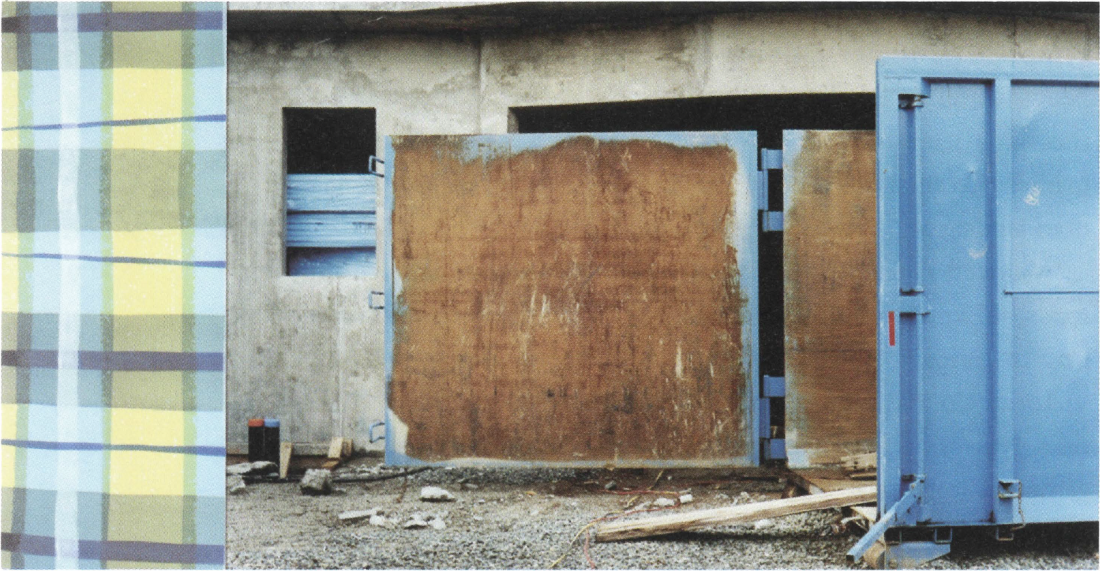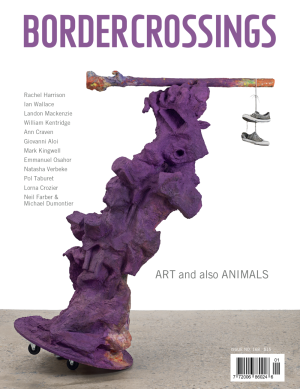Ruth Beer
There exists a curious relationship with nature here in Vancouver, where land and resources seem to exist together as polar opposites, and efforts to bring them into harmony create contrasting results. The sight of construction cranes, like gulls feeding on English Bay, have become as much a part of the city’s landscape as the glitter of civilization at the foot of the noble mountains across the water in North Van. One need not look any further than the infamous Downtown Eastside, where addiction, crime and despair coexist with new loft-style condos and an empty shopping emporium, just two wayward blocks away from the tacky tourist destination of Gastown, peddling smoked salmon and Haida totem-pole key chains. This is a city constantly in the flux of redevelopment, where the old is torn (or, more recently, burned) down to make way for the new. Glittering towers are grafted onto Ma Nature, with savvy marketing schemes behind them; 2010 is on its way and it’s a buyer’s market.
Development is spoken of in hushed tones here, not fully accepted but not actively resisted, either—the city is full of contested zones where environmental, historical and cultural considerations are rarely addressed by those building or buying into them. There seems to be an attitude of acquiescence among many, but the issues of place, identity, commodity and desire seem to be the terrain of much artistic discourse in Vancouver. The contrast and combination of these factors are explored frequently by artists such as Arni Haraldsson, Vikky Alexander, Roy Arden, Lawrence-Paul Yuxweluptun and Brian Jungen, among others. It seems that for every clear-cut or new tower in False Creek blotting out the view of the mountains, another local artist adds their voice to this dialogue.
Ruth Beer is a Vancouver artist and educator whose practice has been primarily in sculpture. For her new exhibit, “Home & Garden” (located, appropriately enough, in Van City’s chi-chi shopping mecca, Robson Street), she explores these issues by marrying photographic and sculptural practices—not just as an investigation of materiality, but also as takes on the systematic compartmentalization of nature in relation to design and commerce in situ.

Ruth Beer, Belmont St., 2004, photograph and arborite, 23 x 42”. Courtesy the artist.
Large C-prints taken in Sasamat Park, Point Grey and the site-in-progress for the UBC’s new revenue generator—student and private housing for sale on campus—are coupled with swatches of Arborite in various colours and patterns. The incorporation of these mundane building materials in faux wood grain, granite and tartan (which, incidentally, are created through a photographic process—look closely for the raster dots in your kitchen counter) adds to the reading of the images. They are not diptychs, per se, but part of the work.
Sasamat Park, for instance, is a crisp C-print of a lone tree standing in a park that was formerly a farm, and First Nations land before that; the grass in the lower third of the frame bleeds into the green Arborite cladding at the bottom. For the bulk of the work, though, it is the content, rather than the addition of material, that is the most readable. Tree shows the chaos of a soon-to-be backyard, littered with scraps of building materials and, you guessed it, a mature prêt-à-porter tree, plucked from the ground, its roots bundled up, ready to be planted wherever the homeowner sees fit. Slide is quintessentially “BC”—a house in progress is foregrounded by a play structure. Rock-climbing holds are incorporated into its bendy Karim Rashid-like design, and the whole tableau is made luminous by Vancouver’s trademark overcast sky.
Complementing the photo work are two sculptures, made from materials commonly found at Home Depot (oops, I mean Rona). Corner is like a wooden puzzle piece, its interior face contrasted with a layer of Arborite in a rich navy blue. The yellowish wood grain and blue material together shout “Ikea!!,” showing how branding and colour can imprint on us, while Stack is a rectangle of butcher block on castors. At about a metre and a half high and made of utilitarian material, it stands awkward, awaiting some kind of practical use. It could be a riff on minimalist sculpture, perhaps, or, with a few strategic slits, it could be a knife block. Maybe there’s a sculpture inside, waiting to be revealed. Or perhaps a dresser.
Overall, the show is understated and her treatment of the subject appears gentle, but is actually quite sly, considering that we’re dealing with a city’s relentless paving-over of heritage, history and nature. It’s an interesting irony that the work was for sale in a commercial gallery in the middle of Vancouver’s glitziest consumption zone, and perhaps this was accidental. I can only hope that some of the work is now hanging in the living rooms of a new pre-fab subdivision somewhere in the Greater Vancouver Regional District, and how that would be oddly subversive and satisfying. ■
“Ruth Beer: House and Garden” exhibited at the Art+Soul Gallery in Vancouver from April 8 to June 4, 2004.
Christopher A. Olson is an ex-pat Winnipegger, freelance writer, multidisciplinary artist and student based in Vancouver.

